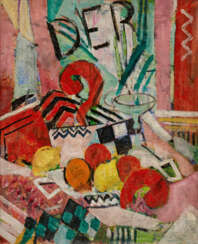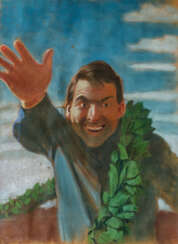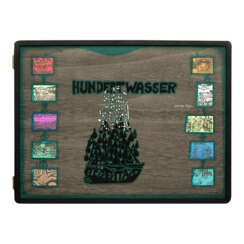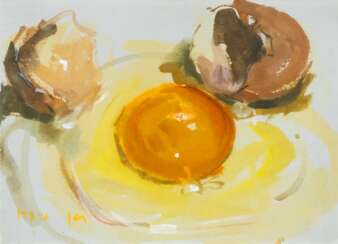haus der deutschen kunst

Heinrich Maria Davringhausen was a German painter associated with the New Objectivity. Davringhausen was born in Aachen. Mostly self-taught as a painter, he began as a sculptor, studying briefly at the Düsseldorf Academy of Arts before participating in a group exhibition at Alfred Flechtheim's gallery in 1914. He also traveled to Ascona with his friend the painter Carlo Mense that year. At this early stage his paintings were influenced by the expressionists, especially August Macke.


Aert van der Neer was a Dutch painter of the Gilded Age.
Van der Neer is considered a pioneer of the night landscape because of his successful solutions to lighting issues in his works. He painted many pictures of winter landscapes, including nighttime fires.


Paula Moderzohn-Becker was a German early expressionist painter.
In her youth she attended the traditional School for Women Artists in Berlin. Like many local German artists, she painted sentimental landscapes and scenes from peasant life.
And in 1900 Paula traveled with her husband to Paris, where she was influenced by post-Impressionist paintings and became an ardent enthusiast of painting by Paul Gauguin and Paul Cézanne. Today she is considered a forerunner of Expressionism because of the power of her compositions, although during her lifetime she was completely ignored. During her short career Moderzohn-Becker painted 750 canvases, about 1,000 drawings and 13 etchings, all of which incorporated the major art movements of the early 20th century.


Martin Kippenberger was a German artist known for his extremely prolific output in a wide range of styles and media, superfiction as well as his provocative, jocular and hard-drinking public persona.
Kippenberger was "widely regarded as one of the most talented German artists of his generation," according to Roberta Smith of the New York Times. He was at the center of a generation of German enfants terribles including Albert Oehlen, Markus Oehlen, Werner Büttner, Georg Herold, Dieter Göls, and Günther Förg.


Oskar Moll was a German post-impressionist painter.
He studied painting in Munich and Berlin, met Henri Matisse in Paris in 1907 and took part in the founding of the Matisse Academy. He later taught at the Art Academy in Düsseldorf, from where he was eventually fired and branded as a propagator of degenerate art, one of his exhibitions was also banned by the Nazis and his works confiscated.
In his paintings, Moll combined linear structures with spaces of color, creating abstract and lyrical landscapes, still lifes and portraits. Contrasting color accents and ornamental motifs enliven the paintings.


Emil Nolde, a German-Danish artist, stands out as a pivotal figure in the Expressionist movement, celebrated for his vibrant use of color and dynamic brushwork. Born on August 7, 1867, Nolde was initially self-taught, developing a style that later became synonymous with expressive use of color and form. His early work included religious themes and landscapes, characterized by their emotional intensity and innovative color palette. Nolde's contributions to art were not limited to painting; he also excelled in printmaking, creating a significant body of work that includes etchings, woodcuts, and lithographs.
One of Nolde's most noteworthy periods was his time spent on the Baltic Sea island of Alsen from 1903 to 1916, where he produced seascapes that captured the natural world's dynamic essence. His painting "Meer Bei Alsen" (Sea Off Alsen) is a testament to this period, showcasing his ability to convey movement and emotion through color. Furthermore, Nolde's fascination with religious and mythological themes is evident in works like "Dance Around the Golden Calf," where he employs vivid colors and expressive figures to explore complex narratives.
Despite his artistic achievements, Nolde's life was not without controversy. During the Nazi regime, his work was labeled "degenerate," and he faced significant professional and personal challenges. Nonetheless, Nolde continued to create, producing a series of watercolors known as the "Unpainted Pictures" during this time. After World War II, Nolde's reputation was rehabilitated, and he was once again celebrated as a leading figure in modern art.
Nolde's legacy is preserved at the Nolde Foundation Seebüll, a museum dedicated to his life and work, established in the year of his death, 1956. His influence on the field of modern art, particularly within Expressionism, is undeniable, with his bold approach to color and form inspiring subsequent generations of artists.
For art collectors and experts, Nolde's work offers a compelling study in the evolution of modern art, reflecting the tumultuous times he lived through and his unyielding dedication to artistic expression. His ability to capture the essence of his subjects, from the natural beauty of the sea to the depths of human emotion, makes his work a valuable addition to any collection.
To stay updated on sales and auction events related to Emil Nolde's work, signing up for updates is recommended. This subscription service ensures you're informed about the latest opportunities to acquire pieces by this influential artist.


Friedrich Wilhelm Otto Modersohn was a German painter of the late 19th and first half of the 20th centuries. He is known as a landscape painter, a representative of the Barbizon School.
Otto Modersohn produced Barbizonian-style landscapes early in his career, but from about 1890 his style became more expressionist, with an emphasis on his choice of colors. The death of his second wife influenced his style: the colors became darker and the images more stark. Modersohn was one of the founders of the Worpswede artists' colony. A large collection of his works is kept in the Modersohn Museum in Fischerhude, and a street in Berlin is also named after him.
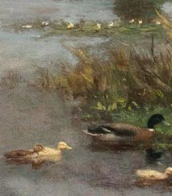

Friedrich Wilhelm Otto Modersohn was a German painter of the late 19th and first half of the 20th centuries. He is known as a landscape painter, a representative of the Barbizon School.
Otto Modersohn produced Barbizonian-style landscapes early in his career, but from about 1890 his style became more expressionist, with an emphasis on his choice of colors. The death of his second wife influenced his style: the colors became darker and the images more stark. Modersohn was one of the founders of the Worpswede artists' colony. A large collection of his works is kept in the Modersohn Museum in Fischerhude, and a street in Berlin is also named after him.


Friedrich Wilhelm Otto Modersohn was a German painter of the late 19th and first half of the 20th centuries. He is known as a landscape painter, a representative of the Barbizon School.
Otto Modersohn produced Barbizonian-style landscapes early in his career, but from about 1890 his style became more expressionist, with an emphasis on his choice of colors. The death of his second wife influenced his style: the colors became darker and the images more stark. Modersohn was one of the founders of the Worpswede artists' colony. A large collection of his works is kept in the Modersohn Museum in Fischerhude, and a street in Berlin is also named after him.


Heinrich Maria Davringhausen was a German painter associated with the New Objectivity. Davringhausen was born in Aachen. Mostly self-taught as a painter, he began as a sculptor, studying briefly at the Düsseldorf Academy of Arts before participating in a group exhibition at Alfred Flechtheim's gallery in 1914. He also traveled to Ascona with his friend the painter Carlo Mense that year. At this early stage his paintings were influenced by the expressionists, especially August Macke.


Heinrich Maria Davringhausen was a German painter associated with the New Objectivity. Davringhausen was born in Aachen. Mostly self-taught as a painter, he began as a sculptor, studying briefly at the Düsseldorf Academy of Arts before participating in a group exhibition at Alfred Flechtheim's gallery in 1914. He also traveled to Ascona with his friend the painter Carlo Mense that year. At this early stage his paintings were influenced by the expressionists, especially August Macke.


Friedensreich Regentag Dunkelbunt Hundertwasser was an Austrian visual artist and architect who also worked in the field of environmental protection.
Hundertwasser stood out as an opponent of "a straight line" and any standardization, expressing this concept in the field of building design. His best known work is the Hundertwasserhaus in Vienna, which has become a notable place of interest in the Austrian capital, characterised by imaginative vitality and uniqueness.


Friedrich Schaper is a German painter, graphic artist and illustrator.


Edgar Carl Alfons Ende was a German surrealist painter, father of children's author Michael Ende and member of the Munich Secession.
Edgar Ende's work belongs to the tradition of fantasy and visionary art, and is considered one of the most important contributions of twentieth-century German painting to this style.
By the end of 1936 his paintings were considered 'degenerate art', and his work and exhibitions were banned by the Nazi regime. After the end of the war, Edgar Ende was one of the co-founders of the professional association of Munich artists, and for the first time participated in the Venice Biennale.
Since 1963 he has been an honorary member of the Academy of Fine Arts in Munich.

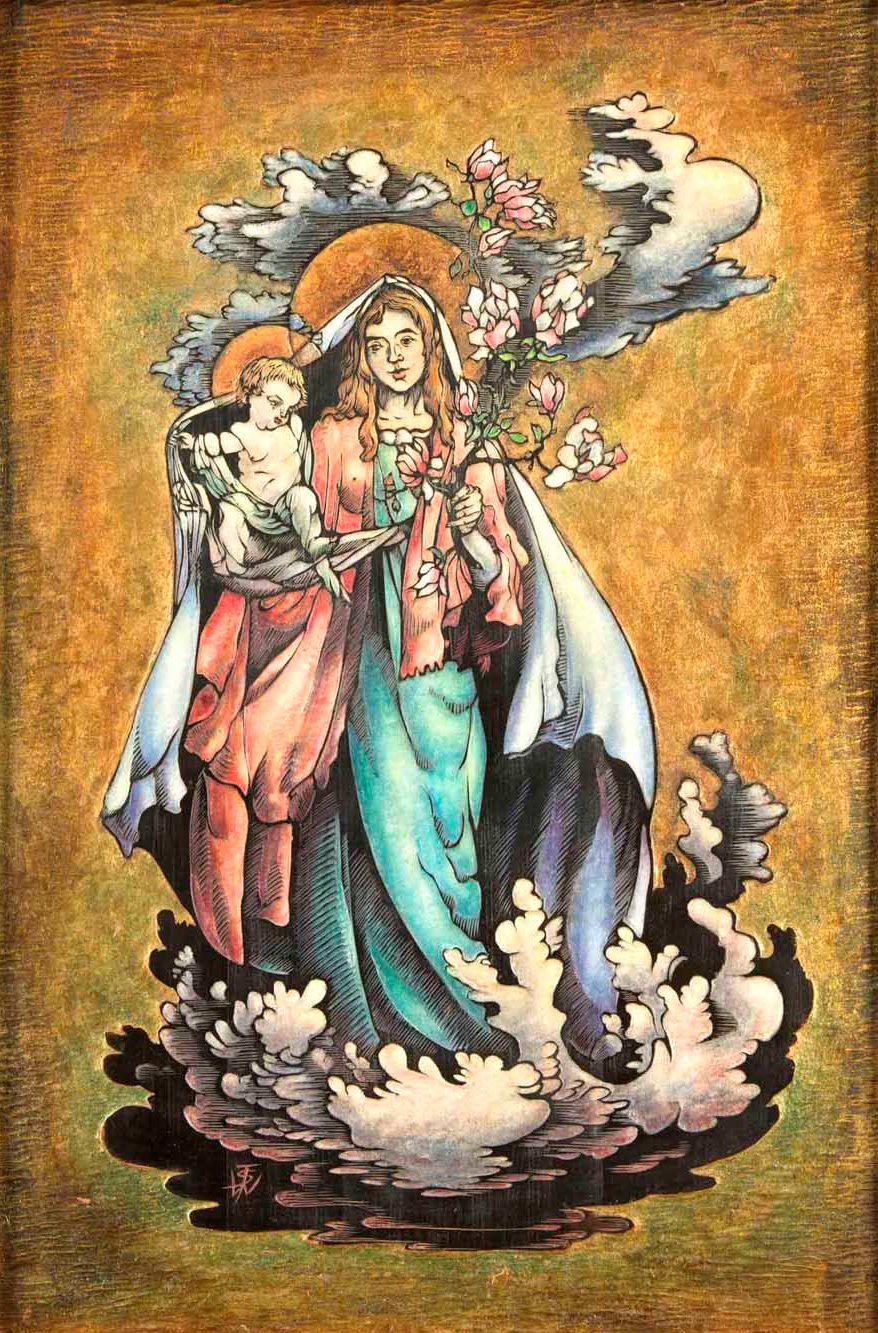


Paul Wunderlich was a German painter, sculptor and graphic artist. He designed Surrealist paintings and erotic sculptures. He often created paintings which referred to mythological legends.


Friedensreich Regentag Dunkelbunt Hundertwasser was an Austrian visual artist and architect who also worked in the field of environmental protection.
Hundertwasser stood out as an opponent of "a straight line" and any standardization, expressing this concept in the field of building design. His best known work is the Hundertwasserhaus in Vienna, which has become a notable place of interest in the Austrian capital, characterised by imaginative vitality and uniqueness.


Friedrich Wilhelm Otto Modersohn was a German painter of the late 19th and first half of the 20th centuries. He is known as a landscape painter, a representative of the Barbizon School.
Otto Modersohn produced Barbizonian-style landscapes early in his career, but from about 1890 his style became more expressionist, with an emphasis on his choice of colors. The death of his second wife influenced his style: the colors became darker and the images more stark. Modersohn was one of the founders of the Worpswede artists' colony. A large collection of his works is kept in the Modersohn Museum in Fischerhude, and a street in Berlin is also named after him.


Friedel Anderson is a German landscape, architectural and object painter.
Friedel Anderson's artistic work encompasses a wide range of techniques and motifs, from landscapes painted against nature, city and harbour views to portraits and still lifes. The landscapes initially focused on the Nordic region. Later, regular journeys through Europe (Italy, France, England) and Africa expanded the themes of his travel and landscape paintings. Anderson found further focal points of his work in shipping, the industrial working world, as well as in the cultural and natural spaces around harbours, rivers and industrial ruins. Interiors and still lifes are also among Anderson's important motifs.


Friedel Anderson is a German landscape, architectural and object painter.
Friedel Anderson's artistic work encompasses a wide range of techniques and motifs, from landscapes painted against nature, city and harbour views to portraits and still lifes. The landscapes initially focused on the Nordic region. Later, regular journeys through Europe (Italy, France, England) and Africa expanded the themes of his travel and landscape paintings. Anderson found further focal points of his work in shipping, the industrial working world, as well as in the cultural and natural spaces around harbours, rivers and industrial ruins. Interiors and still lifes are also among Anderson's important motifs.


Friedel Anderson is a German landscape, architectural and object painter.
Friedel Anderson's artistic work encompasses a wide range of techniques and motifs, from landscapes painted against nature, city and harbour views to portraits and still lifes. The landscapes initially focused on the Nordic region. Later, regular journeys through Europe (Italy, France, England) and Africa expanded the themes of his travel and landscape paintings. Anderson found further focal points of his work in shipping, the industrial working world, as well as in the cultural and natural spaces around harbours, rivers and industrial ruins. Interiors and still lifes are also among Anderson's important motifs.


Friedel Anderson is a German landscape, architectural and object painter.
Friedel Anderson's artistic work encompasses a wide range of techniques and motifs, from landscapes painted against nature, city and harbour views to portraits and still lifes. The landscapes initially focused on the Nordic region. Later, regular journeys through Europe (Italy, France, England) and Africa expanded the themes of his travel and landscape paintings. Anderson found further focal points of his work in shipping, the industrial working world, as well as in the cultural and natural spaces around harbours, rivers and industrial ruins. Interiors and still lifes are also among Anderson's important motifs.


Friedel Anderson is a German landscape, architectural and object painter.
Friedel Anderson's artistic work encompasses a wide range of techniques and motifs, from landscapes painted against nature, city and harbour views to portraits and still lifes. The landscapes initially focused on the Nordic region. Later, regular journeys through Europe (Italy, France, England) and Africa expanded the themes of his travel and landscape paintings. Anderson found further focal points of his work in shipping, the industrial working world, as well as in the cultural and natural spaces around harbours, rivers and industrial ruins. Interiors and still lifes are also among Anderson's important motifs.


Friedel Anderson is a German landscape, architectural and object painter.
Friedel Anderson's artistic work encompasses a wide range of techniques and motifs, from landscapes painted against nature, city and harbour views to portraits and still lifes. The landscapes initially focused on the Nordic region. Later, regular journeys through Europe (Italy, France, England) and Africa expanded the themes of his travel and landscape paintings. Anderson found further focal points of his work in shipping, the industrial working world, as well as in the cultural and natural spaces around harbours, rivers and industrial ruins. Interiors and still lifes are also among Anderson's important motifs.


Friedel Anderson is a German landscape, architectural and object painter.
Friedel Anderson's artistic work encompasses a wide range of techniques and motifs, from landscapes painted against nature, city and harbour views to portraits and still lifes. The landscapes initially focused on the Nordic region. Later, regular journeys through Europe (Italy, France, England) and Africa expanded the themes of his travel and landscape paintings. Anderson found further focal points of his work in shipping, the industrial working world, as well as in the cultural and natural spaces around harbours, rivers and industrial ruins. Interiors and still lifes are also among Anderson's important motifs.












